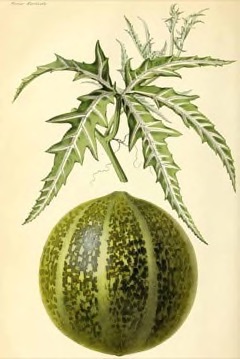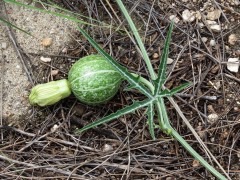 |
|
edibleplants.org |
 |
| wikimedia.org Katja Schulz |
Translate this page:
Summary
Cucurbita digitata is a prostrate vine with a deep root found in hot, arid regions with low rainfall. It is one of only a few xerophyte species in the genus Cucurbita. As a Carbon Farming Solutions plant it is a good protein-oil staple Crop; each white seed is about 35% protein and 50% fat.
Physical Characteristics

 Cucurbita_digitata is an evergreen Perennial growing to 5 m (16ft) by 0.2 m (0ft 8in) at a medium rate.
Cucurbita_digitata is an evergreen Perennial growing to 5 m (16ft) by 0.2 m (0ft 8in) at a medium rate.
See above for USDA hardiness. It is hardy to UK zone 10.
Suitable for: light (sandy), medium (loamy) and heavy (clay) soils, prefers well-drained soil and can grow in nutritionally poor soil. Suitable pH: mildly acid, neutral and basic (mildly alkaline) soils. It cannot grow in the shade. It prefers dry or moist soil and can tolerate drought.
UK Hardiness Map
US Hardiness Map
Synonyms
No synonyms are recorded for this name.
Plant Habitats
Edible Uses
Carbon Farming Solutions - Staple Crop: protein-oil (The term staple crop typically refers to a food that is eaten routinely and accounts for a dominant part of people's diets in a particular region of the world) [1-1]. The fruit is bitter and generally not edible. The fruit is a dark green squash, rounded or nearly rounded, with mottling and distinct white stripes. A few animals may eat the flesh while trying to get at the seeds. Each white seed is about a centimeter long and at 35% protein and 50% fat is a nutritious food.
References More on Edible Uses
Medicinal Uses
Plants For A Future can not take any responsibility for any adverse effects from the use of plants. Always seek advice from a professional before using a plant medicinally.
None Known
References More on Medicinal Uses
The Bookshop: Edible Plant Books
Our Latest books on Perennial Plants For Food Forests and Permaculture Gardens in paperback or digital formats.

Edible Tropical Plants
Food Forest Plants for Hotter Conditions: 250+ Plants For Tropical Food Forests & Permaculture Gardens.
More

Edible Temperate Plants
Plants for Your Food Forest: 500 Plants for Temperate Food Forests & Permaculture Gardens.
More

More Books
PFAF have eight books available in paperback and digital formats. Browse the shop for more information.
Shop Now
Other Uses
Seed oil is made from a number of plants in the Cucurbita genus. For example, Buffalo gourd oil is a seed oil, extracted from the seeds of the Cucurbita foetidissima. The seeds of the Buffalo gourd are rich in oil and protein, and were used by American Indians to make soap. The oil's fatty acid composition is dominated by linoleic acid (64.5%) and oleic acid (17.1%).[
Special Uses
References More on Other Uses
Cultivation details
Climate: subtropical. Humidity: arid to semi-arid. A hairy vining plant similar in appearance to its close relative Cucurbita palmata but the lobes of its leaves are usually more slender. It is a prostrate vine, rarely climbing, with a deep root and slender branches. These species form the only restricted xerophyte species group in the genus Cucurbita. Carbon Farming Solutions - Cultivation: new crop. Management: standard (Describes the non-destructive management systems that are used in cultivation) [1-1].
References Carbon Farming Information and Carbon Sequestration Information
Temperature Converter
Type a value in the Celsius field to convert the value to Fahrenheit:
Fahrenheit:
The PFAF Bookshop
Plants For A Future have a number of books available in paperback and digital form. Book titles include Edible Plants, Edible Perennials, Edible Trees,Edible Shrubs, Woodland Gardening, and Temperate Food Forest Plants. Our new book is Food Forest Plants For Hotter Conditions (Tropical and Sub-Tropical).
Shop Now
Plant Propagation
Seed.
Other Names
If available other names are mentioned here
Calabacillo, Menoncillo, chichi coyota, chichicayote, meloncillo, melón de coyote, calabaza amarga, calabacilla, Finger-Leaf Gourd, fingerleaf gourd, finger-leafed gourd, coyote gourd, Bitter squash.
Native Plant Search
Search over 900 plants ideal for food forests and permaculture gardens. Filter to search native plants to your area. The plants selected are the plants in our book 'Plants For Your Food Forest: 500 Plants for Temperate Food Forests and Permaculture Gardens, as well as plants chosen for our forthcoming related books for Tropical/Hot Wet Climates and Mediterranean/Hot Dry Climates. Native Plant Search
Found In
Countries where the plant has been found are listed here if the information is available
Mexico, North America, USA
Weed Potential
Right plant wrong place. We are currently updating this section.
Please note that a plant may be invasive in one area but may not in your area so it’s worth checking.
None Known
Conservation Status
IUCN Red List of Threatened Plants Status : This taxon has not yet been assessed

Growth: S = slow M = medium F = fast. Soil: L = light (sandy) M = medium H = heavy (clay). pH: A = acid N = neutral B = basic (alkaline). Shade: F = full shade S = semi-shade N = no shade. Moisture: D = dry M = Moist We = wet Wa = water.

Expert comment
Author
A. Gray
Botanical References
Links / References
For a list of references used on this page please go here
Readers comment
| Add a comment |
|
If you have important information about this plant that may help other users please add a comment or link below. Only comments or links that are felt to be directly relevant to a plant will be included. If you think a comment/link or information contained on this page is inaccurate or misleading we would welcome your feedback at [email protected]. If you have questions about a plant please use the Forum on this website as we do not have the resources to answer questions ourselves.
* Please note: the comments by website users are not necessarily those held by PFAF and may give misleading or inaccurate information.
To leave a comment please Register or login here All comments need to be approved so will not appear immediately.
|
Subject : Cucurbita_digitata
|
|
|
|